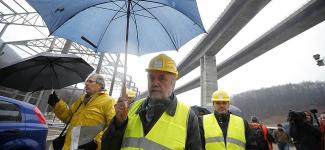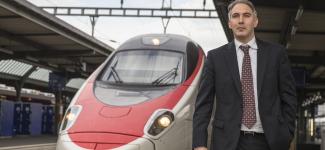Home › Projects › White Book › Land transportation networks and corridors
Land transportation networks and corridors

Giuseppe Sciarrone, the cofounder of the Italian private railway operator NTV and one of the leading advocates of European alternative carriers, explains where we are headed with the abolition of traditional railway operators’ monopolies.
Sustainable eco-friendly development should be one of the main goals of global economic policy in the 21st century. It is well known that transport systems are one of the key sources of pollution and, in addition, account for a significant share of electricity consumption. Thus transport must play a key role in ensuring sustainable development. This means that environmental and energy efficiency requirements in the design of transport networks should no longer be considered simply as an obligation that must be met. They should be seen as a crucial factor in the modernisation and development of the transport sector.
There are at least three ways in which the transport sector can contribute to the health of the planet. First of all, it can contribute by producing environmentally friendly vehicles. Second, through the development of more energy efficient and eco-friendly transport systems. Third, through decongesting large cities. There is no doubt that to achieve this goal trains can and should play a leading role. It is required to ensure the mobility of people in major conurbations through the creation of integrated transport networks of all possible types of rail transport from trams and metros to regional railways.
Railway transport development can also ensure the mobility of people and freight along the major transport corridors through the upgrading and/or construction of long-distance rail links. Indeed, major conurbations and large transport corridors best illustrate railway’s potential; i.e. the ability to transport a large number of people and freight along certain routes within a limited period of time.
High speed rail, as we know, is being developed around the world. In 2010, there were 10,000 km of high speed rail in operation globally. And despite the recent economic crisis and a slowdown in new projects, we can expect that the overall network of high-speed rail by 2030 will amount to more than 30,000 km.
Today it is recognised around the world that high speed rail is the right solution for railway companies seeking to resolve issues related to passenger transportation along high passenger traffic routes.There are two main reasons for that.
The first reason is that high speed rail can significantly increase the quality of passenger service. The success of a transport system has always depended primarily on speed. The history of railways has been driven by the desire to reach ever higher speeds: from 47 km/h of the first steam locomotive George Stephenson (1829) to 574.8 km/h of Alstom’s high-speed train AGV (2007), not to mention magnetic levitation trains.
Secondly, in most cases the new high-speed lines are built in areas already served by traditional railway lines. Consequently, the new high-speed rail really can increase the carrying capacity of a rail system. It has a positive impact not only on the passenger transport over medium and long distances (on new high-speed rail), but also on freight and intra-regional passenger transport (on traditional lines). This is because new high-speed rail relieves pressure on the existing lines, freeing up space for local passenger trains and for freight.
However, accepting the fact that the new high-speed rail is almost always justified in the context of a general expansion of the railway system leaves unresolved the following question: should new high-speed rail serve exclusively passengers or can it also carry freight?
Despite the recent economic crisis and a slowdown in new projects, we can expect that the overall network of high-speed rail will amount to more than 30,000 km by 2030.
In most cases, as world experience shows, preference is given to the transportation of passengers over medium and long distances.
This choice is due to at least three reasons. Firstly, specialised usage allows all trains run at the same speed on the new line and as a result have the same travel time. This maximises the carrying capacity of the new infrastructure.
Secondly, thanks to the common speed and the resulting increase in reliability, specialised usage significantly increases the service trust level. This is one of the most important factors determining passengers’ transport choice. Moreover, experience has shown that introducing mixed usage system on a traditional line significantly reduces its reliability.
Thirdly, the maximum speed of freight trains meets the traditional rail line standards, but not high speed rail requirements. Of course, it is advisable to upgrade the fleet of freight trains, to bring their efficiency as close as possible to that of high-speed trains. Especially since if freed from passenger service, traditional lines will be able to guarantee the shipping speed and reliability required by the market.
However, all of this together does not mean that it is impossible to consider the possibility of a freight train with special characteristics for use on high-speed rail. For instance, when there is a need to transport freight in a particularly short period of time, thus requiring transportation speeds exceeding that of trains on traditional lines.
In any case, it is desirable that such special freight trains are sent on high-speed rail only during limited periods of the day, without creating situations specific to the use of mixed usage systems.
The main consideration in the design of high-speed networks is placing the terminals in such a way as to ensure maximum availability of the high speed trains to residents of large cities.
Large cities around the world are characterised by the increasing decentralization of places to live and work, while existing railway stations are usually located in city centres. As central districts usually feature heavy traffic, the benefits of high-speed rail risk being whittled down due to how long it takes to reach the station from suburbs. However, if the existence of a “central station” is essential, it seems advisable to establish extra “stops” (i.e. stations, not necessarily large) equipped with large parking lots along the high speed rail, locating them in peripheral areas on the main axes of roads leading from or into the city, in order to secure complete integration of high speed rail with urban public transport networks and private vehicles.
For these purposes, special attention should also be given to the integration of high-speed rail with air transport to ensure air transport passengers can easily access any point in the country using high speed rail upon arrival. Therefore, it is important to ensure that high speed railway stations are located close to large airports.
When considering high-speed rail in the light of ongoing projects in Russia and Turkey, it is advisable to ensure their coordination both with each other and at the same time with the European high-speed rail network, i.e. they should ideally provide for transport continuity between neighbour countries. This means that it would be useful for such new projects to take into account the European high speed rail interoperability criteria and standards.
Obstacles to interoperability can be broken down into three categories: the difference in track width, the difference in power systems and the difference in signaling systems.
The “physical-infrastructure” problem relating to different gauges is the most difficult to solve, two other “system” obstacles can be eliminated through effective planning of rolling stock. These obstacles mean we have to abandon the idea of full integration of high-speed rail networks.
Some remarks should also be given on the transportation of freight as far as large regular flows along transport corridors are considered. It has already been noted that the transportation of freight, with a few exceptions, does not require high speed and, therefore, does not need to use new high speed rail.
In this regard, the more logical solution is to send freight trains along traditional rail lines, which are well suited for this. In this context, we can talk about the two main areas of activity.
The first concerns the rail network load and off-load points. For this it is necessary to take into account that the future of rail freight, in all likelihood, is represented by two types of trains: (1) trains equipped only for the carriage of freight commonly used to transport goods from the place of production and/or storage, and (2) trains designed for mixed (intermodal) transport in a "road plus rail", in which the freight is carried in boxes and/or shipping containers by lorries or other road vehicles at the beginning and end of the journey transported by rail for the rest of it. The later intermodal method can also be seen in “sea plus rail”, whereby freight is transported by rail after a long sea journey.
These types of intermodal systems offer significant development potential and require rail network managers to plan for these possibilities through identifying suitable locations for terminals and ensuring that they are suitably equipped.
In the case of multimodal transport in “sea plus rail” such terminals should obviously be placed in ports and designed in such a way as to ensure efficient load and off-load operations.
In the case of “road plus rail” multimodal transport requires so-called “cargo transhipment points” to be effective. There has been significant growth in the number of cargo transhipment points in Europe in the last twenty years. They need to be properly equipped to allow both for intermodal operations and operations associated with the processing of cargo, including storage, and packaging.
Efficient and optimised networks of ports and cargo transhipment points are a necessary condition for the creation of modern systems of freight transportation.
The second area of activity, in addition to cargo transhipment points, requires the introduction of a so-called rail template for the line used by freight trains. Currently there is a tendency to curb transport tariffs by increasing the dimensions of the unit load. Making use of traditional lines, providing access to rail with bulky cargo units is another important condition for significant development of rail freight.
Rail networks throughout the world have always been run as monopolies by large state-owned companies.
Over twenty years ago, in the early 90s, the European Union decided to open the rail transport market to competition, based on the fact that in comparison with well-developed road and air transport, rail was increasingly losing its market share, and its position could only be restored through abandoning the traditional monopoly in favour of a liberalised and, as a consequence, competitive system.
For today freight (since 1999) and intermodal passenger (since 2010) transport has been fully liberalised in Europe, while the inland passenger transportation of people is liberalised only in Italy (since 2012).
Efficient and optimised network of ports and cargo transhipment points are a necessary condition for the creation of modern systems for freight transportation.
Countries in the region that wish to create a new modern transport system should consider the following question: can liberalisation help to increase the share of rail transport?
Undoubtedly, the answer will be yes, if liberalisation creates competition between rail operators based on improving service quality and curbing prices. New operators entering the market can only succeed through high levels of quality and reasonable prices, thus forcing the traditional monopoly companies to improve and creating a positive spiral for the benefit of the market and passengers.
The Italian experience may be the most advanced in Europe and is of great importance in this respect both in the transport of freight and in the transport of passengers by high speed rail.
In the case of freight liberalisation, this affected primarily international connections between Italy and central and northern regions of Europe through the central Alpine arch (Sempione, Gottardo and Brenner). When new operators, which all aimed to increase the quality of service (in the case of freight this mainly means punctuality), entered the market, the established market operator reacted positively by aligning itself with the same levels of punctuality. The result was annual growth of 10% from 2000 (compared to an annual growth of 1-2% in the 90 years prior to liberalisation), an increase that lasted almost until the end of the first decade of this century, when a serious economic crisis significantly reduced volume of freight transported.
In the case of passenger traffic, liberalisation has affected the services offered in the new Italian high-speed rail network (Turin-Milan-Bologna-Florence-Rome-Naples, around 1,000 km) and resulted in a new railway company, Nuovo Trasporto Viaggiatori (NTV), entering the market in April 2012. Since then the company has been competing successfully with the old monopoly (Trenitalia).
The result was very positive and can be generalised as follows: in one year alone (i.e. 2012), during a severe economic crisis that hit almost all economy sectors, the high-speed rail ridership increased by 15% compared with the previous year. For example, NTV transported more than two million passengers and its competitor’s (Trenitalia’s), traffic volume not only suffered no reduction, but even increased by 6–7%.
This increase was due to a significant improvement in the quality-price ratio of the service (the quality was much higher while the prices were reduced by 30%) and is distributed as follows: one-third can be accounted for passengers switching to rail from air, another third for those switching from private road transport and the rest for new passengers attracted by an improvement of services and lower prices.
Of course, the Italian experience also shows that liberalisation is a complex and delicate process and requires a host of other improvements.
One solution is a complete separation, not only from the point of view of accounting, but also in terms of belonging to the same company, between the company providing infrastructure management and responsible for security, and companies that operate the services. This allows for all rail operators to engage in equal competitive conditions.
Currently, in all countries, infrastructure managers are members of the same monopolistic company to which the state railway operator belongs. This enables the later to enjoy a significant and unjustified competitive advantage.
At a time when the countries of the region are launching large-scale programs of modernisation and improvements in the transport sector and, in particular, the rail network, the liberalisation of the industry and the separation of the operating companies from the infrastructure managers are two issues requiring discussion and solution in the shortest possible time.
http://www.kommersant.ru/doc/2424436
Sign up for MIR initiative email updates
Sign up to receive monthly notifications about new arctiles published and other events on your email.
Other articles
 Mario Virano
Mario Virano
Environmentally compatible transport infrastructure
 Thomas Maier
Thomas Maier
Transport infrastructure investments
 Jorge Miarnau
Jorge Miarnau
Railway into the future
 Yury Spektorov
Yury Spektorov
Transportation Projects in METR Region – Strategic Implementation Aspects
 Jan C. Harder
Jan C. Harder
Localisation as a challenge
 Jan C. Harder
Jan C. Harder
